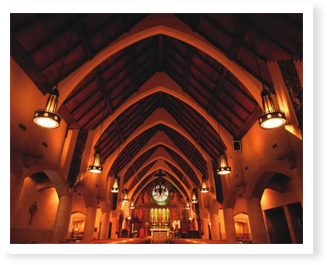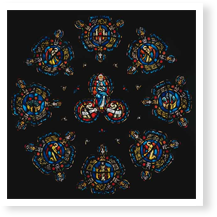History
 In the mid 1980s, there was a substantial hardening of the insurance market, especially in the area of casualty insurance. As a result, it was not uncommon to see increases of up to 400% for liability charges. Also, some coverages became unavailable in the marketplace. For instance, municipalities and day care centers were two entities that were seriously impacted.
In the mid 1980s, there was a substantial hardening of the insurance market, especially in the area of casualty insurance. As a result, it was not uncommon to see increases of up to 400% for liability charges. Also, some coverages became unavailable in the marketplace. For instance, municipalities and day care centers were two entities that were seriously impacted.
As a result, Catholic Mutual Group, along with a number of Dioceses, explored the possibility of forming an excess liability pool. This endeavor became a reality with the formation and commencement of operation of the Catholic Umbrella Pool (CUP) on July 1, 1987. There were 16 charter members, and this number has since grown to over thirty members.
CUP had several requirements which naturally excluded many Dioceses from being able to participate in the Pool. These included 100% participation in the $3.5 million excess liability layer, heavy capitalization, and a high level of Risk Management services. Through a similar process, Catholic Umbrella Pool II (CUP II) was formed and commenced operation on July 1, 1989 with 31 charter members. There are currently over 60 Arch/Dioceses that participate in CUP II.
Purpose
CUP II’s primary purpose was to form an excess liability pool which would allow for participation by the smaller to medium sized Dioceses and still be attractive to all Dioceses. The Pool would provide broad coverages at the lowest possible cost. More importantly, the Pool would have the effect of the stabilization of pricing and would not be susceptible to the volatility of the insurance market. The Pool also introduces Risk Management techniques into Diocesan policy and procedures.
Initially, the Pool’s participation rate was at the 25% level. Through strategic planning, CUP II increased their participation on a pro-rata basis of the $4 million layer excess of the $1.5 million underlying coverage; on July 1, 1992 the participation level was increased to 50%; on July 1, 1994 the participation level was increased to 75%. The eventual goal of assuming the entire $4 million excess layer was realized on July 1, 1995.
Effective July 1, 2003 CUP II restructured its participation. To further the goal on self insuring within the Catholic Church, CUP II became a co-participant for 5% of Catholic Mutual while retaining 50% of the 3.5 million excess 1.5 million layer for its own members.
Requirements
Participation in the Pool is limited to Dioceses that:
- Are listed in the Official Catholic Directory.
- Participate in Catholic Mutual.
- Are approved for admission by the Executive Committee of CUP II and Catholic Mutual.
- Agree to the terms and conditions of the CUP II Participation and Administrative Agreements.
Costs
Costs will vary by individual Dioceses*. Basically, the capitalization and contribution amounts will be a function of the actual charge for the coverage by the marketplace.
Contribution
This is the annual payment that is made to the fund similar to a premium charge.
Risk Management
Initially, this fee is a small percentage of the excess liability charge. After the first year, it is computed on an actual time and expense basis.
* Actual figures would be provided to any interested Dioceses.
Services
In order to protect the assets of the Pool and to minimize the exposure to loss, the Executive Committee and Catholic Mutual feel it is necessary to implement a Risk Management Program that would be effective, yet cost efficient.
These objectives will be accomplished through the utilization of Catholic Mutual:
- Annual loss prevention inspections will be conducted at all locations of a high-risk category of each participating Diocese. These high risk locations will be facilities such as, but not limited to, high schools, grade schools, retreat/pastoral centers, children’s homes or detention centers, cathedrals and large churches, as well as other locations.
- Catholic Charity operations, youth ministry, fleet safety and large-scale cemetery operations will be reviewed.
- A self-inspection program will be implemented and administered by Catholic Mutual.
- Pertinent safety literature will be made available and distributed.
- Seminars/workshops may also be conducted.
With a comprehensive Risk Management program in place, identification and correction of hazardous conditions should result in a decrease in the frequency and severity of losses. The benefits gained from this program will impact not only in the Liability area, but also in other lines of coverage. For example, a safety inspection may reveal a fire hazard that was previously undetected; or, identifying and correcting a slip and fall hazard would not only provide safe passage for visitors to the premises, but would also be beneficial for the safety of the employees.
Benefits
 Members of CUP II enjoy many benefits. First and foremost is the sharing of information that takes place. In addition to that which pertains to the Pool, in coming together, a member may find solutions or guidance to problems that they may be experiencing and have already been resolved by a fellow participant.
Members of CUP II enjoy many benefits. First and foremost is the sharing of information that takes place. In addition to that which pertains to the Pool, in coming together, a member may find solutions or guidance to problems that they may be experiencing and have already been resolved by a fellow participant.
Each member of CUP II "owns" a portion of the Pool’s funds. With continued success and good claim history, members will be eligible for dividends or return of contribution.
With emphasis on Risk Management, services can be obtained at a more economical cost. Reduction of losses in all areas as a result can further help to maintain costs. There are also other economies that may be enjoyed due to the size of the Pool.
It is difficult to quantify all the benefits served from the participation in the Pool. However, in the long run, members of CUP II will not be as susceptible to the volatility of the insurance market and will in essence control their own destiny regarding insurance.
FOR MORE INFORMATION, PLEASE CONTACT CUP II ADMINISTRATOR:
Catholic Mutual Relief Society
Mike Intrieri, President & Chief Executive Officer
10843 Old Mill Road
Omaha, NE 68154-2600
(800) 228-6108
FAX (402) 551-2943